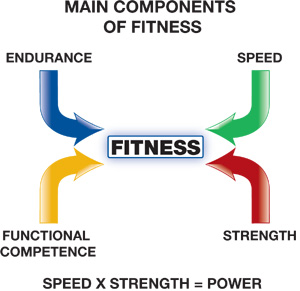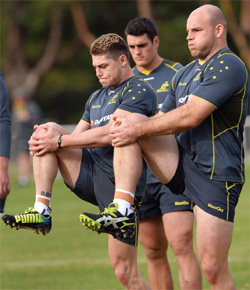Physical conditioning
Improving your fitness can make you a better player and less prone to injury. For players, coaches and those who design physical conditioning programmes for Rugby players, you need to have a general understanding of the key components of fitness and also the specific physiological demands of the Game.
What follows is a brief introduction to the area of physical conditioning for Rugby. If you would like more detailed information, please register for and complete World Rugby’s online Level 1 Strength and Conditioning programme at https://passport.world.rugby/conditioning-for-rugby/
What are the components of physical conditioning?

Speed is the ability to coordinate simple or complex limb movements at high velocity.
Strength is the maximum force an individual can exert through a muscle or group of muscles, against an external resistance.
Endurance is a measure of the body’s ability to maintain a rate of work.
Functional competence is the extent to which a player has good stability and mobility during movements related to the game.
Power = Speed x Strength.
In Rugby, all players require a degree of each of these components, but the relative importance of each component will vary according to a player’s playing position.
Principles of training
- Individuality. People react to the same training stimulus in different ways. The main reasons are: genetic; initial fitness levels; maturity.
- Adaptation. When you train regularly, physiological changes take place over time to make you more effective and efficient.
- Overload. To improve your fitness, you must continually progress the work you perform.
- Work / Play vs Rest / Regeneration. Although it is important that training load is progressive, time for rest and regeneration is just as important.
- Specificity. Fitness is specific and your training must relate to the demands of the game you play.
- De-training. Any prolonged lay-off from training will be accompanied by a drop-off or de-training of fitness levels. So, you should undertake a reconditioning programme before you return to full training / play.
Needs analysis
Rugby players need varying amounts of strength, power, endurance, speed and agility from its players. There are few team sports that require such a diverse and comprehensive range of physical attributes.
The different demands of the various playing positions should also influence how you train. For example, the front five players in the scrum require power and endurance to scrummage effectively, whereas a flanker will make more frequent sprints throughout a game and as a result require higher levels of speed and speed endurance.
For you to be physically prepared - to be truly Rugby Ready - basic functional competence must be in place. For example, you must develop a good general base in terms of strength, stability, mobility and endurance as a platform on which to build enhanced speed and power qualities.
For an accurate and relevant needs analysis, you should seek the help of a registered or accredited conditioning coach to design and implement the conditioning programme. Primary considerations are:
- Your current physical condition using standardised physical tests and functional assessment
- Any history of injury
- Training history: this needs to take into account training age (the number of years you have been specifically preparing for Rugby) and fitness training age (the number of years you have been supervised by an accredited strength and conditioning coach)
- Specific game-related needs (playing position, refereeing, etc.)
Once individual needs have been determined based on these criteria, specific issues relating to rehabilitation / prehabilitation and perceived weaknesses can be focused on and a training programme can be designed and implemented to meet these needs.
Regular monitoring and evaluation of your progress will require testing procedures to be in place. This will ensure that the programme is constantly changing and progressing to meet new objectives.
Functional assessment
A functional assessment can be conducted using simple exercises such as the overhead squat with a basic balance test, as seen here.




High level of functional competence




Low level of functional competence
Functional assessment should be completed by an accredited strength and conditioning coach in order to determine your current level of mobility and stability. The information from the test can then be used to design an appropriate strength training programme and enable you to achieve full mobility and good stability. This will prepare your body for work, increase your capacity for work and correct muscle imbalances.
The type of strength required for Rugby is a specific type of strength which often has to be deployed in conditions of instability.
So a fitness programme for Rugby must focus on the development of stability of the potential injury sites such as the shoulder, core, hip, knee and ankle, rather than placing an excessive emphasis on gym-based weight lifting.
The World Rugby level 1 and Level 2 strength and conditioning courses cover the functional assessment in more detail. For more information, visit
https://passport.world.rugby/conditioning-for-rugby/
Planning a conditioning programme
There are a number of variables to consider:
- your age
- your training age
- your long-term and short-term goals
- the availability of facilities and resources
The other key consideration is the phase of the Rugby season. The timing and length of the season varies across the world. Whatever the timings of your season, you will need to plan your training around four distinct phases:
- Off season
- Pre-Season
- In-Season
- Transition
This process is called periodisation.
| Phase | Off season | Pre-Season | In-Season | Transition |
| Activity | General preparation | Specific preparation | Maintenance | Recovery / active rest |
| Southern Hemisphere | Nov-Jan | Feb-March | April-July | Aug-Oct |
| Northern Hemisphere | May-June | July-Aug | Sept-April | May |
*Months are approximate and may vary according to the Union and level of play.
When designing your weekly plan, an important consideration is the 48-hour rule. Recent research in Rugby* has shown that you can still be fatigued 48 hours after an intense game. Your plan should reflect this, so high-intensity training should be avoided for 48 hours after a game. A sample weekly plan is shown here.
| Day | Activity |
| 0 | Match |
| 1 | Recovery |
| 2 | Strength and conditioning training, or recovery option |
| 3 | High-intensity Rugby training |
| 4 | Strength and conditioning training |
| 5 | Medium to low-intensity Rugby training |
| 6 | Rest |
| 7 | Match |
* Source: Evaluation of muscle damage after a Rugby match with special reference to tackle plays. Takarada Y. Br J Sports Med. 37. 416-419. 2003.
This is only one of many possible plans and is only designed to show how the 48 hour rule can be integrated to the training week.
General training tips

- Ensure you complete a warm up (use dynamic stretches) and cool down (use static stretches) for all sessions (see the warm-up and cool down sections)
- Good nutrition and hydration are extremely important to support your conditioning
- Wherever possible, get the help of a registered or accredited physical conditioning coach
- Try to train with someone else or, even better, train in groups following similar programmes
- Try to keep your sessions fun and varied
- Try to develop match fitness through conditioned games and Rugby-specific drills such as those shown below